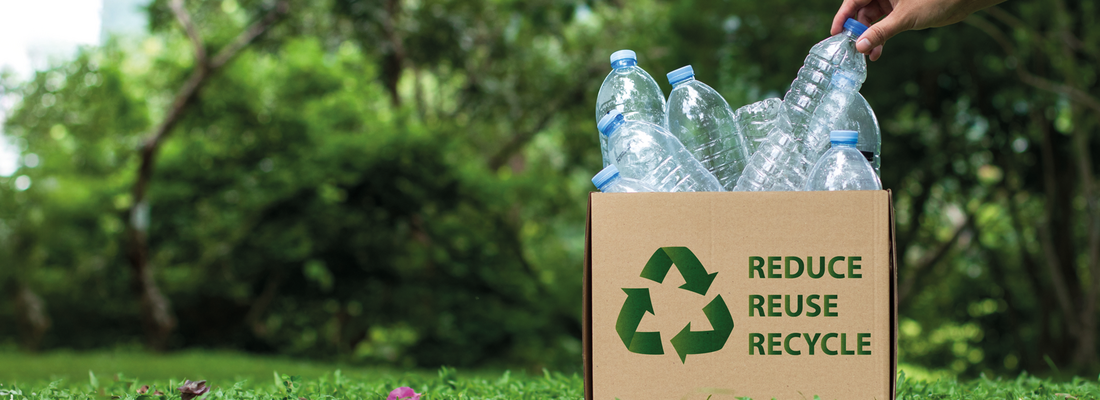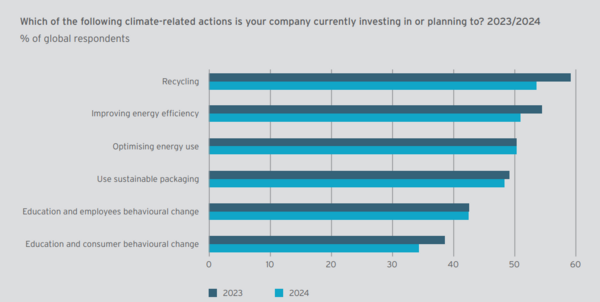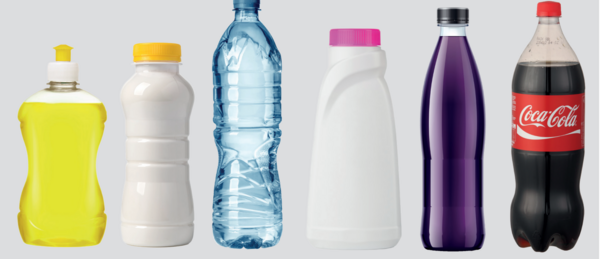

(Photo credit: Shutterstock)
Recycling
Euromonitor - Rigid Plastics’ Circularity: Demand for Renewable Packaging Intensifies
There is ever-growing expectation for sustainable packaging. The search for better is reflected in consumer sentiment and regulatory attention. The focus on plastic goes wide with regulation increasingly the lever used to secure more rapid progress on the road towards a circular economy.
The value of rigid plastics and the size of the circularity challenge
Rigid plastic packaging amounted to 1.1 trillion packs in 2023, meaning this group of pack types represents 28% of global grocery packaging sales. Demand is led by PET bottles for soft drinks and thin wall plastic containers, the latter strongly specified across food end-uses, including yoghurt, butter and ice cream.
Rigid plastic is the first choice for many grocery products due to the versatility it affords brands in pack sizing, shaping/design and how it assures product protection, shelf life and prevents waste, ably packing multiple ingredient formats from powders to solids to liquids.
Food and soft drinks are the two largest end-uses for rigid plastics and are forecast to account for 90% of global rigid plastic packaging growth between 2023 and 2028. The PET bottle leads as the second most specified of the 40 consumer pack types we track. PET-bottled soft drinks are most significant and are set to be an even more important constituent of rigid plastic sales, with Asia Pacific the headline growth region, forecast a 3.7% CAGR over 2023-2028. The Middle East and Africa also hold strong forecast dynamics. Edible oils, dairy (milk and yoghurt) and dishwashing are further prospects for PET.
Its light weight brings distribution efficiency, especially positive in a time not only of persisting cost pressures for manufacturers and price pressures for consumers, but also of growing environmental pressures to increase the adoption of pack solutions that lower greenhouse gas emissions. Environmental scrutiny on rigid plastics, however, is strong as concerns around plastics’ polluting presence as waste remain steadfast.
_______________
1 in 2 of all rigid plastic packs are PET bottles for soft drinks - Source: Euromonitor International Passport Packaging
_______________
What is also apparent is that where concerns about the eco-profile of plastics and plastic pollution are strong, plastic demand is weaker. Western Europe has the weakest outlook for PET bottles in soft drinks, with growth of less than a 1% CAGR forecast for 2023-2028 with beverage cans and glass faring better. Coca-Cola’s investment in new refillable glass lines in Europe reflects the region’s concerns.

Consumers and regulators want action on plastic
Two thirds of consumers are worried about climate change and associate climate concerns with packaging, especially plastic, as apparent in the actions that consumers take to live more sustainably.
In Euromonitor International’s global Voice of the Consumer: Lifestyles Survey, fielded January to February 2024, three of the top five actions consumers are taking involve packaging. “Reduce plastics use” is at the top of these, closely after “reduce food waste”, and followed by recycling and using sustainable packaging.
Regulation is set to accelerate change on reducing plastic’s environmental impact, from broad pieces of climate legislation, such as the US Inflation Reduction Act and European Climate Law, to regional and national packaging policies, where the focus is on building a cleaner, circular economy.
Europe leads the way in specific packaging and plastics-specific laws. The Packaging and Packaging Waste Regulation (PPWR), which saw formal adoption of the text in April 2024, is important for the impact it can make, considering the size of the EU, to advance progress on plastics’ circularity. Targets include waste reduction, pack recyclability and material recovery and reuse, including increasing the use of recycled content in plastic packaging.
_______________
In the new EU rules, there are challenging targets for beverage manufacturers with the mandate for 90% collection of all single-use plastic bottles by 2029, and to make 10% available in durable refillable packaging by 2030 - Source: Euromonitor International from the EU’s Packaging and Packaging Waste Regulation (PPWR) 2024
_______________
Recyclability, recycling and reuse are integral
Prioritising design for recyclability and/or composting needs to be combined with scaled-up collection, recycling and reuse of rigid plastics, to truly instil circular economy principles and reduce waste.
_______________
“Sustainable packaging” is promisingly the top sustainability claim that businesses are pursuing in their new product launches in 2024 - Source: Euromonitor Voice of the Industry: Sustainability Survey April 2024
_______________
Progress is apparent in pack redesigns specifying recyclability, reduced material use and, most markedly for rigid plastics, the replacement of virgin materials with recycled. Orkla Foods in Sweden has, for instance, switched from polypropylene (PP) to a lighter, recyclable PET bottle that contains a minimum 25% rPET content, while Aldi in the UK has transitioned all its soft drinks bottles to 100% rPET. These redesigns help brands reduce their carbon impact and drastically reduce dependence on higher-emitting virgin polymers.
Label-free bottles are witnessing more trials as a solution to reduce plastic use. Coca-Cola Great Britain launched a label-free trial for Sprite PET bottles in 2024. This continues the circular evolution of Sprite packaging, following its earlier switch from iconic green to transparent bottles, which is important given PET’s recyclability value is greatest in its clear form.

Redesign via recyclate to reduce carbon impact
The specification of recycled polymers use over virgin content importantly help businesses to reduce their carbon impact, this a top sustainability priority of businesses, as they pursue climate goals and netzero targets. Recycled PET is considered to have around half the footprint of new virgin-produced PET, making its specification a credible means for brands to achieve substantial carbon reduction.
Better recycling is essential to increase recyclate capacity. Businesses increasingly recognise this, which is why recycling was the leading climaterelated action for investment in surveys conducted by Euromonitor in 2023 and 2024. Private label challenges brands in the race to drive down virgin plastics use, with Aldi in the UK transitioning all its soft drinks PET bottles to 100% rPET, which it expects will save 10,000 tonnes of virgin plastic annually. Higher demand for recyclate is continuing to be seen across food, drinks, beauty and home care.
Recycled plastic specification brings the renewable potential of plastic to the fore. Communicating credentials that consumers trust, eg “recyclable” and “recycled content”, can help brands improve the narrative, for plastic to be viewed as a viable sustainable material destined for reuse.
The power of policy to spur collective momentum
Regulation, such as the PPWR, has the potential not only to advance packaging progress beyond current corporate actions, but also to impact beyond Europe if wholly or in part replicated, as governments around the world take note, seeking to make good on their own climate and packaging pledges.
_______________
51% of professionals in 2023 cite “comply with legislation” as the reason for investing in sustainability, up significantly from 41% in 2022 - Source: Euromonitor Voice of the Industry: Sustainability Survey April 2024
_______________

The EU’s Single-Use Plastic Directive target for tethered caps, which came into full effect in July and mandates tethered caps on plastic beverage packaging up to 3-litres in size, shows how regulation can deliver change, to reduce the loss of plastic caps to litter. Tethered caps are now a familiar sight across Europe. On a more local level, the UK’s Plastic Packaging tax, levied on material with less than 30% recycled content, has already strongly increased the use of recycled resins in packaging, and extending to labels and multipacks.
We expect a rise in the implementation of extended producer responsibility (EPR) programmes and deposit return schemes (DRS) to further improve packaging collection, recycling and reuse. There is also a much-anticipated global UN plastic treaty, expected by the end of the year, that could bring an internationally harmonised approach to the handling of plastics as the push for renewable packaging intensifies.
To future-proof rigid plastics, companies should embed design circularity and inform consumers on progress made. The hand of regulation will undoubtedly add impetus for greater action. Many businesses today have investment plans that target recyclability, compostability, recycling and reuse; more will need to act, as regulation strengthens.
The comPETence center provides your organisation with a dynamic, cost effective way to promote your products and services.

magazine
Find our premium articles, interviews, reports and more
in 3 issues in 2025.

